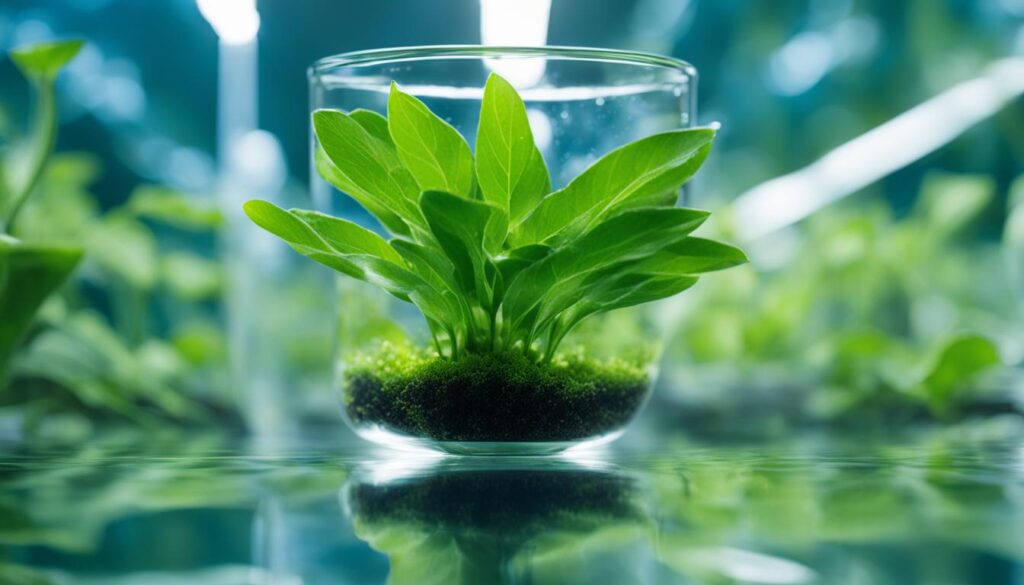As a plant enthusiast, I know how frustrating it can be when your plants are not thriving as they should. One common issue that many growers face is silicon deficiency. But don’t worry, I’m here to help you understand how to fix this problem and ensure your plants are healthy and vibrant.
Key Takeaways:
- Silicon deficiency can negatively impact plant health and yield.
- Common symptoms of silicon deficiency include foliage discoloration, rusty leaves, and stunted growth.
- It is important to monitor water pH levels and the silicon content in the growing medium.
- Silicon deficiency in soil can be addressed through the addition of diatomaceous earth or specialized fertilizers.
- In hydroponic setups, introducing silicon through nutrient solutions or foliar sprays can remedy silicon deficiency.
Importance of Silicon in Plant Nutrition
Silicon is a vital micronutrient that plays a crucial role in plant nutrition. Its benefits extend beyond supporting overall plant growth – it also enhances the plant’s ability to withstand environmental stresses and increases resistance to pests and diseases.
One of the key functions of silicon is its role in strengthening the plant’s structure. It promotes the development of robust stems, leaves, and roots, which in turn improves the plant’s ability to withstand physical stressors such as wind and heavy rain.
By reinforcing the plant’s structural integrity, silicon helps prevent stem breakage and leaf damage, ensuring optimal plant health.
Moreover, silicon enhances the plant’s resistance to pests and diseases. It works by forming a physical barrier on the plant’s surface, making it more challenging for insects and pathogens to penetrate and infect the plant.
This natural defense mechanism reduces the risk of infestations and diseases, leading to healthier plants and higher yields.
| Benefits of Silicon in Plant Nutrition | How Silicon Contributes |
|---|---|
| Enhanced structural integrity | Strengthens stems, leaves, and roots |
| Improved resistance to pests and diseases | Forms a physical barrier on the plant’s surface |
| Enhanced photosynthesis | Increases chlorophyll production and efficiency |
| Higher yields and better floral quality | Optimizes plant growth and development |
Furthermore, silicon plays a role in enhancing photosynthesis, the process through which plants convert sunlight into energy. By increasing chlorophyll production and efficiency, silicon helps the plant maximize its ability to capture and utilize light energy, resulting in higher yields and improved floral quality.
While silicon deficiency is more prevalent in hydroponic setups, it is important to ensure an adequate supply of silicon in all types of plant cultivation.
By prioritizing silicon as a vital nutrient, growers can create an optimal growing environment that supports healthy plant growth, increases resistance to stressors, and ultimately leads to more productive harvests.
How to Spot Silicon Deficiency in Plants
Silicon deficiency in plants can have significant impacts on their overall health and growth. It is important to identify the signs of silicon deficiency early on to prevent further damage and ensure optimal plant development. Here are some common symptoms to look out for:
1. Foliage Discoloration:
Plants suffering from silicon deficiency may exhibit discoloration in their foliage. This can manifest as yellowing, browning, or even rusty patches on the leaves. Keep a close eye on the color of your plant’s foliage as an early indication of silicon deficiency.
2. Leaf Drying and Curling:
Another telltale sign of silicon deficiency is the drying and curling of leaves. You may notice that the leaves become brittle, dry out quickly, and begin to curl inward. This can be particularly evident in the younger leaves of the plant.
3. Poorly Developed Roots:
Silicon deficiency can also impact the development of a plant’s roots. Plants lacking sufficient silicon may have shallow, weak root systems that are not able to absorb nutrients efficiently. This can further hinder the plant’s growth and overall health.
4. Other Symptoms:
In addition to the above, silicon deficiency can also manifest in drooping leaves, stunted growth, and increased susceptibility to pest infestations and fungal diseases. It is important to carefully observe your plants for any signs of these symptoms.
To prevent and address silicon deficiency, it is crucial to monitor the pH levels of the water, the quantity of water provided, and the silicon content in the growing medium.
By ensuring a balanced nutrient environment and promptly addressing any deficiencies, you can help your plants thrive and reach their full potential.
In summary, identifying silicon deficiency in plants requires careful observation of foliage discoloration, leaf drying and curling, poorly developed roots, and other associated symptoms.
By actively monitoring and addressing these signs, you can ensure healthy plant growth and minimize the risk of nutrient deficiencies.
Solving Silicon Deficiency in Soil
Silicon deficiency in soil can have detrimental effects on plant health and growth. However, there are several effective methods to address this issue and ensure optimum silicon levels in the soil. By incorporating the following solutions, you can successfully treat silicon deficiency in your plants:
1. Diatomaceous Earth
Diatomaceous earth is a natural source of silicon that can be added to the soil to replenish silicon levels. It is composed of the fossilized remains of diatoms, a type of algae rich in silicon. When applied to the soil, diatomaceous earth not only provides silicon but also helps improve soil structure, drainage, and water retention.
2. Silicate Salts
Another effective method of treating silicon deficiency is by using silicate salts, such as potassium silicate or sodium silicate. These salts contain available forms of silicon that can be easily absorbed by plants. They can be applied as a soil drench, mixed with water and applied directly to the root zone.
3. Liquid Silicon
Liquid silicon solutions are also available in the market and can be added directly to the soil to provide a readily available source of silicon. These solutions are easy to apply and are quickly absorbed by the plant roots, promoting rapid silicon uptake and improving plant health.
When using specialized plant meals or fertilizers containing silicon, it is crucial to check the label to ensure they contain sufficient amounts of silicon.
Over-application of silicon can lead to toxicity, so it is important to follow the recommended dosage and application instructions provided by the manufacturer.
By implementing these solutions, you can effectively treat silicon deficiency in soil and promote healthy plant growth. Regular monitoring of silicon levels and proper supplementation will help ensure optimal plant health and yield.
Solving silicon deficiency in hydroponic setups

When it comes to hydroponic setups, addressing silicon deficiency is crucial for enhancing plant health and maximizing yield. There are various methods to introduce silicon into your hydroponic system, ensuring your plants receive the necessary nutrient for optimal growth.
Using Silicon Nutrient Solutions
One effective solution is to add silicon nutrient solutions to your hydroponic nutrient mix. Sodium silicate, also known as liquid glass, is a commonly used silicon nutrient solution.
It can be easily mixed with your nutrient solution according to the manufacturer’s instructions. Another option is potassium silicate, which can be added to your fertilizer solution, providing a dual benefit of essential nutrients.
Exploring Foliar Sprays
In addition to nutrient solutions, foliar sprays can be used as a short-term remedy to replenish silicon levels in hydroponic plants. These sprays contain silicon compounds that can be applied directly to the leaves, allowing for quick absorption.
It’s important to note that foliar sprays should be used in conjunction with root supplementation for long-term silicon mobility.
Supplementing with Silicon-Rich Mediums
Another approach is to use silicon-rich mediums in your hydroponic system. This can include incorporating diatomaceous earth or other silicate-rich substances into your growing medium.
These mediums gradually release silicon, ensuring a steady supply for your plants throughout their growth cycle.
By implementing these strategies, you can effectively address silicon deficiency in hydroponic setups and enhance the overall health and productivity of your plants. Remember to carefully follow the manufacturer’s instructions when using nutrient solutions or foliar sprays, and regularly monitor your plants for signs of improvement.
Continued attention to silicon nutrition will help your hydroponic plants thrive, allowing them to develop strong structures, resist pests and diseases, and ultimately achieve optimal growth and yield.
What is silicon toxicity?
Silicon toxicity is a condition where plants exhibit symptoms of having an excess of silicon. Although rare, it is important to understand the effects of silicon toxicity and how it can impact plant health and growth.
Similar to nutrient burn, silicon toxicity can cause leaf discoloration, withering, and other detrimental effects on the overall health of the plant. Ignoring silicon toxicity can have significant consequences on the plant’s ability to thrive and yield desirable results.
Silicon, when present in the right amounts, offers numerous benefits to plant growth. It strengthens the plant’s structure, improving resistance to pests, diseases, and drought.
Silicon enhances photosynthesis, leading to higher yields and improved floral quality. However, an excessive amount of silicon can disrupt the delicate balance of nutrients and hinder plant growth instead of promoting it.
To address silicon toxicity, it is crucial to maintain a balanced nutrient level in plants and take swift action. Flushing the plants with pH-balanced water can help neutralize the excess silicon and restore a healthier environment for growth.
Monitoring nutrient levels and providing the appropriate amount of silicon can prevent the occurrence of toxicity and ensure optimal plant health.
| Symptoms of Silicon Toxicity | Preventive Measures |
|---|---|
| Leaf discoloration | Avoid excessive use of silicon-rich supplements |
| Leaf withering | Monitor nutrient levels regularly |
| Reduced plant growth | Flush plants with pH-balanced water |
By understanding the potential effects of silicon toxicity and taking the necessary steps to prevent it, cannabis growers can maintain a healthy and thriving crop.
Balancing nutrient levels, monitoring plant health, and providing the appropriate amount of silicon can ensure optimal growth and yield, while avoiding any negative consequences associated with silicon toxicity.
Think twice before underestimating silicon
When it comes to optimizing plant health and enhancing yield, one often overlooked micronutrient is silicon. Despite its significance, many growers fail to realize the potential benefits of addressing silicon deficiency in plants.
By incorporating remedies such as foliar sprays or introducing sodium silicate into your cultivation routine, you can strengthen your plants’ resistance to insects, drought, and other environmental stresses.
It’s worth noting that modern plant meals and fertilizers often contain trace levels of silicon, further supporting healthy growth. By carefully selecting superior-quality cannabis seeds and pairing them with a nutrient-rich grow setup, you can create an ideal environment for your plants to thrive.
Don’t underestimate the impact of silicon on plant health and yield. By considering the treatment of silicon deficiencies and incorporating silicon-enhancing techniques into your cultivation practices, you can unlock the full potential of your plants and ensure optimal growth.
Remember, even small changes in nutrient balance can make a significant difference in the long run.
FAQ
How can I fix silicon deficiency in plants?
Silicon deficiency in plants can be addressed by adding diatomaceous earth, silicate salts, or liquid silicon to the soil. Specialized plant meals and fertilizers containing silicon can also be used. In hydroponic setups, sodium silicate or potassium silicate can be added to the nutrient mix, and foliar sprays can be used as a short-term remedy. Make sure to monitor water pH levels and the silicon content in the growing medium to prevent and address silicon deficiency effectively.
What is the importance of silicon in plant nutrition?
Silicon plays a critical role in strengthening the plant’s structure, enhancing photosynthesis, and improving its resistance to pests, diseases, and drought. It also leads to higher yields and better floral quality. While silicon deficiency is rare in outdoor grows, it is more prevalent in indoor hydroponic setups. Adding silicon to plant nutrition can optimize plant health and yield.
How can I spot silicon deficiency in plants?
Silicon deficiency in plants can be identified by symptoms such as foliage discoloration, rusty leaves, leaf drying, curling or drooping leaves, and poorly developed roots. Monitoring water pH levels, water quantity, and silicon content in the growing medium can help prevent and address this deficiency.
How can I solve silicon deficiency in soil?
Silicon deficiency in soil can be addressed by adding diatomaceous earth, silicate salts, or liquid silicon to improve the silicon levels in the soil. Specialized plant meals and fertilizers containing silicon can also be used. It is important to check the label to ensure they contain sufficient amounts of silicon for effective treatment.
How can I solve silicon deficiency in hydroponic setups?
Silicon deficiency in hydroponic setups can be remedied by adding sodium silicate or liquid glass to the nutrient mix. Potassium silicate combined with fertilizer is another option. Foliar sprays can be used as a short-term remedy, but it is important to supplement the roots for long-term silicon mobility. Make sure to carefully follow the recommended dosage for optimal results.
What is silicon toxicity?
Silicon toxicity occurs when there is an excess of silicon in plants. It can cause leaf discoloration, withering, and symptoms similar to nutrient burn. It is important to maintain a balanced nutrient level in plants and take action to neutralize silicon toxicity by flushing the plants with pH-balanced water. Ignoring silicon toxicity can significantly impact plant health and yield.
Why should I not underestimate the importance of silicon?
Silicon is an often overlooked micronutrient in plant nutrition, but it plays a crucial role in optimizing yield and promoting plant health. Addressing silicon deficiency through remedies such as foliar sprays or introducing sodium silicate can help strengthen plants’ resistance to insects, drought, and other stresses. Choosing superior-quality cannabis seeds and pairing them with a nutrient-rich grow setup can further enhance plant health and yield.






